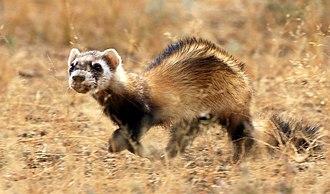4. Reproductive Biology
The reproductive biology of the Steppe Polecat is a fascinating aspect of its life history, shaped by evolutionary adaptations to the challenging environments of Central Asia's steppes and semi-deserts. As with many mustelids, Steppe Polecats exhibit a seasonal breeding pattern, with mating typically occurring during the late winter and early spring months, coinciding with increased prey availability and favorable environmental conditions. During this time, male Steppe Polecats engage in courtship rituals to attract potential mates, often displaying aggressive behaviors and vocalizations to assert dominance and establish breeding territories.
After successful courtship, female Steppe Polecats undergo a gestation period lasting approximately 30 to 40 days, depending on environmental factors and the health of the mother. Following gestation, females give birth to litters of typically three to seven offspring, known as kits, although litter sizes may vary depending on factors such as maternal age, nutrition, and habitat quality. The birthing process typically occurs in underground burrows or dens, providing protection and insulation for the vulnerable newborns against the elements and potential predators.
Upon birth, Steppe Polecat kits are altricial, meaning they are born in a relatively undeveloped state and rely heavily on maternal care for survival. Mother Steppe Polecats exhibit strong maternal instincts, diligently nursing and grooming their offspring, as well as providing warmth and protection within the den. The mother's milk provides essential nutrients and antibodies crucial for the kits' growth and immune system development during the early stages of life.
As the kits grow and develop, they undergo rapid physical and behavioral changes, gradually transitioning from a state of dependence on maternal care to independence. Young Steppe Polecats begin to venture outside the den and explore their surroundings under the watchful eye of their mother, honing their hunting skills and social behaviors through play and interaction with littermates. As they mature, young Steppe Polecats disperse from the maternal territory to establish their own territories and breeding territories, continuing the cycle of reproduction and contributing to the population dynamics of their species.
5. Ecological Role
The Steppe Polecat plays a crucial ecological role in the grassland and semi-desert ecosystems of Central Asia, where it serves as a key predator and contributes to the regulation of prey populations and nutrient cycling. As a mesopredator, the Steppe Polecat occupies an intermediate position in the food chain, preying on smaller vertebrates and invertebrates while also serving as prey for larger predators such as eagles, foxes, and wolves. By controlling the populations of rodents, insects, and other prey species, Steppe Polecats help maintain the balance of their ecosystem and prevent overgrazing and habitat degradation caused by unchecked herbivore populations.
Through their hunting behavior and dietary preferences, Steppe Polecats exert top-down pressure on prey populations, influencing the distribution and abundance of species within their ecosystem. By targeting small rodents such as voles, mice, and ground squirrels, Steppe Polecats help control pest species that can damage crops and disturb soil structure, thus indirectly benefiting agricultural productivity and ecosystem health. Additionally, their consumption of insects contributes to the regulation of insect populations, reducing the risk of pest outbreaks and mitigating damage to vegetation and agricultural crops.
Furthermore, Steppe Polecats play a role in nutrient cycling and energy flow within their ecosystem through their interactions with prey and scavengers. As carnivores, Steppe Polecats consume organic matter derived from prey species, assimilating nutrients and energy into their own biomass. When they die, their remains provide a source of nutrients for scavengers and decomposers, facilitating the breakdown and recycling of organic matter in the environment. This process contributes to soil fertility and ecosystem productivity, supporting the growth of vegetation and sustaining the diverse array of life within the ecosystem.
Beyond their direct ecological impacts, Steppe Polecats also serve as indicators of ecosystem health and integrity. As sensitive species that require suitable habitat conditions and prey availability for survival, their presence or absence can provide valuable insights into the overall health and functioning of their habitat. By monitoring Steppe Polecat populations and their interactions with other species, conservationists can assess the effectiveness of habitat management strategies and identify potential threats to biodiversity and ecosystem stability.
6. Conservation Measures
-
Habitat Protection: Establishing protected areas, nature reserves, and wildlife corridors to safeguard critical habitats for Steppe Polecats and other species. These protected areas should encompass a range of habitat types and provide sufficient space and resources for the species' survival and reproduction.
-
Habitat Restoration: Implementing habitat restoration and reforestation projects to rehabilitate degraded ecosystems and create suitable habitat conditions for Steppe Polecats. This may involve restoring native vegetation, controlling invasive species, and promoting sustainable land management practices that support biodiversity conservation.
-
Human-Wildlife Conflict Management: Developing and implementing strategies to mitigate conflicts between Steppe Polecats and humans, particularly in areas where the species overlaps with agricultural activities or urban development. This may include the use of non-lethal deterrents, such as fencing, sound devices, and livestock guardian animals, to prevent predation on domestic livestock and reduce retaliatory killings of Steppe Polecats.
-
Research and Monitoring: Conducting scientific research and monitoring programs to better understand the ecology, behavior, and population dynamics of Steppe Polecats, as well as the factors influencing their distribution and abundance. This information is essential for designing effective conservation strategies and evaluating the success of conservation efforts over time.
-
Education and Outreach: Raising awareness about the importance of Steppe Polecats and their role in ecosystem health and functioning through public education campaigns, community engagement initiatives, and outreach programs. By fostering a greater appreciation for wildlife conservation and promoting coexistence between humans and Steppe Polecats, conservationists can garner support for conservation measures and inspire local stewardship of natural resources.
-
Policy and Legislation: Advocating for the implementation and enforcement of policies, laws, and regulations that protect Steppe Polecats and their habitats from threats such as habitat destruction, poaching, and illegal trade. This may involve collaborating with government agencies, non-governmental organizations, and local communities to develop conservation policies and strengthen legal protections for the species.






